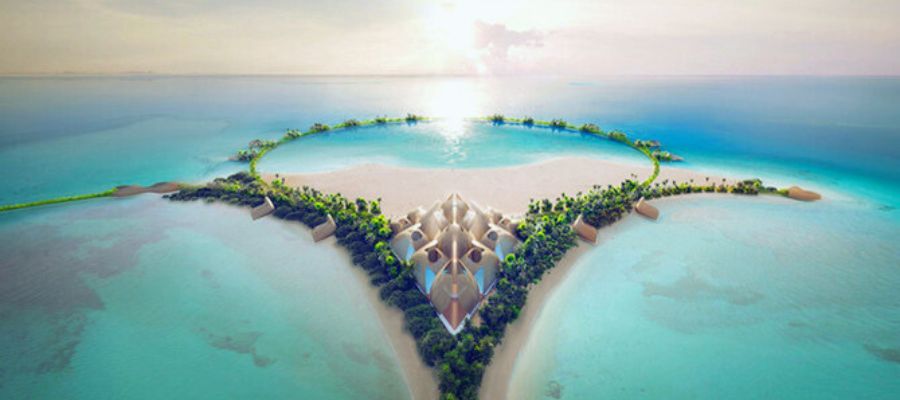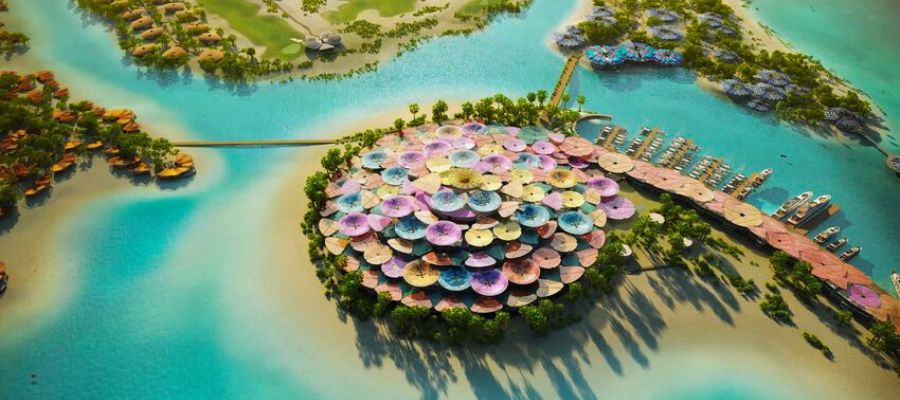The completion of the Red Sea Project will allow Saudi Arabia to compete in global tourism and showcase the partnership between the Kingdom's public and private sectors, according to Minister of Tourism Ahmed Al-Khatib. He highlighted the importance of the public-private sector partnership in developing the tourism sector and increasing its contribution to the economy.

Saudi Arabia has also launched a transit visa, which allows passengers in transit to visit the Kingdom's historical, cultural, and spiritual sites. The Kingdom has invested in various development projects, such as the Makkah Buses project, and aims to provide 108,000 hotel rooms through five major projects in the city, with investments estimated at SR170 billion.
Red Sea Project to Boost Saudi Arabia's Competitiveness in Global Tourism
The Red Sea Project is poised to enhance Saudi Arabia's position in the global tourism industry by offering a luxury and sustainable hospitality destination. As one of the world's most ambitious and exciting tourism and hospitality projects, the Red Sea Project is designed to showcase one of the world's last hidden natural treasures.
The project is expected to enable Saudi Arabia to compete with 100 international tourist destinations and underline the robust partnership between the Kingdom's public and private sectors. Thanks to the government working in collaboration with the private sector, progress is being made towards the completion of the Red Sea Project. This initiative is part of Saudi Arabia's larger tourism strategy, which seeks to provide services, enhance tourism, and create regulations for the private sector.
Saudi Arabia's Tourism Strategy and Public-Private Sector Partnership
Saudi Arabia has implemented a comprehensive tourism strategy aimed at developing the sector and increasing its contribution to the economy. The strategy includes the establishment of numerous projects, the enhancement of tourism services, and the crafting of regulations for the private sector.
To achieve these goals, the Kingdom has fostered a strong public-private sector partnership. The Minister of Tourism, Ahmed Al-Khatib, emphasized the importance of this partnership in his remarks to investors and business owners in the Chamber of Commerce in Makkah.
He noted that this collaboration has played a crucial role in advancing tourism efforts, such as the Air Connectivity Program, which aims to facilitate transportation into and out of the Kingdom. The program spent over SR30 million ($8 million) last year to connect cities directly with Jeddah and Riyadh, and to connect over 22 destinations through direct flights.
Overall, the government's tourism strategy and public-private sector partnership are expected to drive the growth of Saudi Arabia's tourism industry and contribute to the country's economic development.
Air Connectivity Program and Transit Visa to Facilitate Travel to Saudi Arabia
Saudi Arabia has introduced the Air Connectivity Program (ACP) to facilitate travel into and out of the country. The ACP aims to connect cities directly with Jeddah and Riyadh, as well as connecting over 22 destinations through direct flights. Last year, the government spent over SR30 million ($8 million) on the program to improve air connectivity.
In addition to the ACP, Saudi Arabia has also launched a transit visa program that allows passengers stopping over in the Kingdom to obtain an entry visa. The transit visa for stopovers allows entry to Saudi Arabia for people in transit who wish to perform Umrah, visit the Prophet's Mosque in Madinah, or tour the Kingdom.
This new visa program is an electronic service that enables passengers to stay in the country for up to 96 hours, allowing them to explore Saudi Arabia's historical, cultural, and spiritual sites. Both the ACP and transit visa are part of the Kingdom's efforts to enhance its tourism industry and attract more visitors to the country.
Discovering the Hidden Treasures of the Red Sea
The Red Sea region is one of the most beautiful and unexplored areas in the world, with a wealth of natural and cultural treasures waiting to be discovered. From pristine beaches to stunning coral reefs, ancient ruins, and bustling cities, the Red Sea has something for everyone.
A New Era for Tourism in Saudi Arabia
The launch of these new tourist routes marks a new era for tourism in Saudi Arabia, as the country seeks to diversify its economy and become a leading destination for international visitors. The Red Sea region is a key part of this strategy, offering visitors a unique and unforgettable experience.
The Red Sea Development Project: A Vision for the Future

The Red Sea Development Project is one of the most ambitious and exciting tourism projects in the world, aimed at creating a luxury destination around the Red Sea's hidden natural treasures. The project is part of Saudi Arabia's Vision 2030 plan, which aims to transform the country's economy and society.
Exploring the Wonders of AlUla
AlUla is one of the most fascinating and historically significant sites in Saudi Arabia, featuring a well-preserved ancient city, tombs, and rock art. Visitors can explore the area on foot, by bike, or on a guided tour, and experience the rich cultural heritage of the region.
Luxury Accommodations in the Red Sea Region
The Red Sea region offers visitors a range of luxury accommodations, from five-star resorts to eco-friendly lodges and boutique hotels. These properties are designed to blend seamlessly with the natural environment and offer visitors a comfortable and memorable stay.
Adventure Tourism in Saudi Arabia
Adventure tourism is a growing trend in Saudi Arabia, with visitors seeking out unique and thrilling experiences in the great outdoors. The Red Sea region offers a range of activities, including snorkeling, scuba diving, hiking, rock climbing, and more.
The Importance of Sustainable Tourism in the Red Sea Region
Sustainable tourism is a key focus of the Red Sea Development Project, with a commitment to protecting the natural environment and preserving the cultural heritage of the region. Visitors can learn about sustainable tourism practices and contribute to conservation efforts during their stay.
Red Sea Beaches: A Paradise for Water Sports Enthusiasts
The Red Sea region is known for its crystal-clear waters and colorful marine life, making it a paradise for water sports enthusiasts. Visitors can enjoy snorkeling, diving, kite surfing, and more, and explore the vibrant coral reefs and underwater landscapes.
Discovering the History of Jeddah:
Jeddah, a port city on the coast of the Red Sea, has a rich history that dates back to ancient times. Visitors can explore the old town area, Al-Balad, which is a UNESCO World Heritage Site, and admire the traditional coral houses and bustling souks. Jeddah also boasts impressive museums, such as the Abdul Raouf Khalil Museum, showcasing Islamic art and artifacts, and the Jeddah Regional Museum of Archaeology and Ethnography, which explores the region's cultural and historical heritage.
Saudi Arabia's Vision 2030: Transforming the Tourism Industry:
The Vision 2030 initiative launched by Saudi Arabia aims to transform the country's tourism industry, attracting 100 million visitors annually by the year 2030. The plan includes developing new tourist destinations, enhancing existing infrastructure, and increasing the number of tourism-related jobs. The initiative also seeks to promote the country's cultural and historical heritage, including its many archaeological sites and ancient ruins.
To obtain a Saudi Arabia
- Step1: Complete the online application by providing your passport details.
- Step2: Submit payment online using a credit card.
- Step3: Monitor your email for confirmation of payment and receipt of your eVisa, which will be sent electronically.
Recent News
- Saudi Tourism Authority and Trip.com Group sign global agreement to significantly boost tourism numbers
- WTTC celebrates Saudi Arabia milestone surpassing 100 million tourists
- 2024 Ramadan Celebration in Saudi Arabia
- Saudi Arabia Unveils Expo 2030 Visa Initiative
- 5 NEW Visas to Work & Live in Saudi Arabia! (Expats Guide)
- Saudi Arabia's Innovative Residency Programs for Foreign Talent and Investment
- Saudi Arabia Investor Visa Open to All Nations
- Turkey Visa for Saudi Arabia
- Saudi Arabia Expands eVisa Program to 6 Additional Nations
- Verify Your Saudi Visa Application Status
